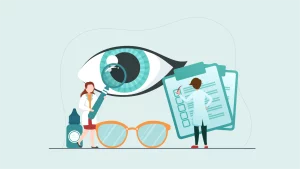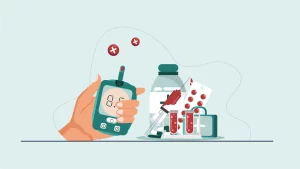The holidays are over and it’s time to return to work, but have you ever had red, dry or burning eyes while at work?
The working environment can be a source of dry eye. Many factors can lead to eye dryness, including stress, screens and even make-up.
Below are some tips to follow regularly to limit the effects of dry eye.
1. Protect your eyes when using a screen
Screen work is becoming more and more common and screens are an integral part of our everyday lives. You may spend seven to eight hours a day at a computer. However, excessive screen use can dry out the surface of the eyes.
As a result, it is important to position the screen so that it is lower than the eyes. When your eyes are looking upwards, a larger area of the eye is exposed to the air and therefore your eyes dry out faster. However, your gaze should not be too low either, or you may impact your posture.
Next, position yourself so there are no reflections on the screen, as these can damage your eyes due to glare. For example, make sure you don’t have a window facing you or behind you.
Ideally, light should come from the sides. You can also wear blue light blocking glasses to protect your eyes from artificial light. Make sure you are working in the right amount of light (not too much or too little).
Finally, it is essential to take breaks. Try following the 20-20-20 rule several times a day. This involves looking 20 feet (about 6 metres) away from you for 20 seconds every 20 minutes.
2. Don’t forget to blink
When we are looking at a screen or concentrating, our blinking frequency decreases. Did you know that blinking plays an important role for our eyes?
It helps stimulate the glands in the eyelids that produce the lipids in our tears. Blinking also contributes to eye hydration by spreading out the tear film. A normal blinking frequency is one blink every four seconds.
You can perform blinking exercises to get used to blinking regularly.
Below is an example of a quick exercise you can do several times a day:
- Close your eyes and count to three.
- Squeeze your eyelids tightly shut and count to three.
- Open your eyes and count to three.
To watch our tutorial, click here.
3. Take care with make-up
Many people wear make-up to work every day, even if it’s just a little. However, make-up can be a key cause of dry eye if it is not used correctly.
First of all, take care when selecting your make-up. Use hypoallergenic products that are suitable for sensitive eyes.
It is important to avoid using powder eye shadows; choose cream ones instead, as these won’t result in dust falling into your eyes.
The same goes for mascara: take care when applying it. Only apply it to the end of the eyelashes, so that it doesn’t end up deposited on the edge of the eyelids where the opening of the meibomian glands is located. These deposits could block the glands and prevent the production of lipids, which are essential to limit tear evaporation.
Finally, if you use eyeliner, apply it to the upper eyelid and above the line of the eyelashes, for the same reason as mascara.
4. Go easy on air conditioning and heating
Excessive use of air conditioning and heating can cause dry eye.
With air conditioning, the air will dry out the eyes by increasing tear evaporation.
Heating, on the other hand, makes the air drier, which dries out the eyes as well.
However, we advise you to ventilate your workspace morning and evening to allow humid air to circulate. A room with a good level of humidity will prevent your eyes from becoming too dry.
5. Pay attention to your diet
When we are at work and have little time to eat, we can be tempted by fast food, for example. However, diet also plays a role in dry eye.
Some foods have benefits for dry eye. Eating foods rich in omega-3 and vitamins will help look after your eyes and keep them working properly.
If you would like more information on diet and dry eye, check out our news item on the topic.
IF THE PROBLEM PERSISTS, SEE AN OPHTHALMOLOGIST.





